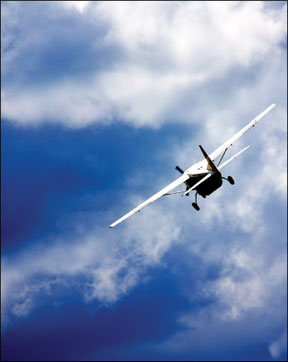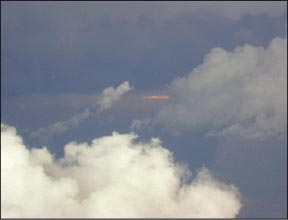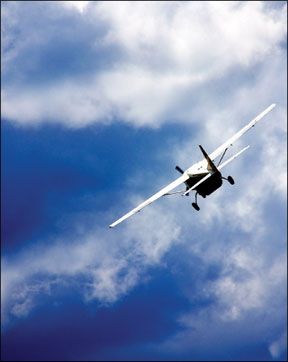There are times when every pilot wishes. Wishes the weather was better; wishes the airplane was newer; wishes it was better equipped and wishes that he hadnt promised passengers they would be home on time. And thats usually the way it begins. Wishful thinking for weather-involved flight, in marginal VFR conditions. Fog, rain and low ceilings are important causes of weather-related general aviation accidents. These accidents can be further broken down; inadequate preflight 288 planning and preparation make up a large percentage. Trying to fly VFR in IFR weather is another. Major risks are those pilots who operate beyond their ability, beyond their IFR currency and beyond their experience levels in IFR. Poor Preparation One pilot who seems to be always with us is the pilot who moves right out into IFR conditions from takeoff, without a trace of fear, immediately experiences disorientation, and within two minutes loses control of the airplane. Then there is also the pilot who attempts to maintain visual contact with the surface in decreasing visibility. He wishes it would improve, but before it does, he hits terrain, or other obstacles. Some VFR pilots (and non-current IFR pilots) fly into conditions for which they are poorly prepared and not qualified even to attempt. Many of these pilots overestimate their flight experience and ability. But they are determined to go. Their attitude toward the weather conditions ahead is (too often) “wishful thinking.” Combine this overly optimistic attitude with poor judgment, and the aircraft accident is “close to happening.” Despite the emphasis made in flight safety meetings, and during flight instruction, there are always pilots out there who dont understand spatial disorientation. All pilots, no matter what their flight experience level may be, are potential victims of spatial disorientation. It can happen when visibility is reduced to zero, or whenever the natural horizon is not clear enough to control the airplane by visual references. This often occurs during marginal VFR conditions. The Sense Of Uuncertainy A flight of four RV-8 aircraft was planned to be a day/VFR formation practice flight from Gilmer, Texas, to Tyler, Texas. After departure, the flight came into an unreported layer of clouds at 1000 feet msl (600 feet agl). The flight leader then climbed through a hole on top of the cloud layer, and leveled off at 3300 feet msl. The leader reported a broken and misty cloud layer above. He stated the broken layer below was “well-defined, with lots of holes to see the ground.” Northwest of Tyler, Texas, the undefined layer above started to come down toward the broken layer below. The conditions worsened, and the lead pilot told his wingmen, as briefed previously, to “go to lost-wingman procedure, and get on the attitude indicator, and start a shallow descent.” Shortly after the leaders call, the number two wingman lost control of his airplane and entered an uncontrolled descent. The pilot was fatally injured and the airplane was destroyed. The NTSB determined the probable cause as: “…the pilots failure to maintain control of the airplane due to spatial disorientation.” How and why do these weather-related general aviation accidents happen? A strong sense of uncertainty, often bordering on panic, grips a VFR pilot when caught on top of a cloud layer. He suddenly finds himself in a completely unfamiliar, and unfriendly, weather environment. So, he often takes great risks to remain below the cloud layer. The pilots control of the situation then fades away rapidly. One source of the pilots confusion is losing sight of checkpoints on the ground. These checkpoints are what he had planned to use to confirm the indications on the radio and navigation instruments in the cockpit. Wishing Wont Make It So Now the VFR pilot, or the non-current IFR pilot, will attempt to remain below a cloud layer. The flight visibility starts to fade away in haze, rain or fog. The ground reference points are beginning to disappear into the marginal visibility behind. Again, this creates another illusion-that the conditions behind are getting worse. This illusion also implies that the conditions ahead are improving. The illusion increases with the speed of the aircraft. The pilot now believes he cant reverse course. It may be his last opportunity. Once the pilot begins to doubt the accuracy of the instruments and navigation equipment, realizing that he wont be able to chart progress over unfamiliar and unseen terrain, personal pressures increase. Some pilots, caught on top of a cloud cover, with conditions of unlimited ceiling and visibility, have become so upset that they have proceeded off course toward any area that seemed to be free of clouds. They hope to regain visual contact with the surface. However, these wishes are often visual illusions. But most pilots will continue to “chase the horizon.” Shortly, they are totally disoriented. In areas where the terrain is rising, or in the mountains, the contrast between the cloud layer and the terrain below can create a false sense of safety. It may seem there is safe clearance between the base of the cloud deck and the terrain. Unfortunately, the mountain tops often penetrate into the clouds. Warnings are available to the VFR pilot who plans his flights carefully. Weather station reports and pilot information reports, describing low ceilings in the mountains, along with obscured ridges are available, and are invaluable for making safe pre- and in-flight decisions. The point is that careful flight planning concerning IFR conditions en route is necessary well before encountering the deteriorating weather. The next major wish problem is fuel remaining. The fuel usually is very low, or running out, when the pilot requests ATC help. Running out of fuel (and lost), then having to descend IFR through a cloud layer into unknown conditions of terrain below, is almost the final stage of panic for the VFR-only, and non-current IFR pilot. VFR-into-IMC Mistakes There are also VFR-only pilots and non-current IFR pilots who get trapped into weather-related accidents by attempting to continue into lowering ceilings. These pilots usually try to maintain visual contact with the surface, which instills greater confidence at a time its sorely needed. These pilots have a natural fear of being caught on top. They take great risks to remain below the cloud layer. 288 Sometimes an illusion develops, indicating that the end of the overcast is just up ahead. This happens when the forward visibility below the cloud deck is unrestricted. A thickening cloud layer-which can appear darker than the area between the lower part of the cloud deck and the surface-completes the illusion the overcasts limit is not very far ahead. Pilots have “chased the horizon” until the aircraft ran out of fuel, or flew into rising terrain. The big pre-flight warnings will come from weather reports and pilot reports, describing low ceilings in the mountains and “ridges obscured.” Generally, inexperienced VFR-only pilots, flying in marginal conditions, tend to lose altitude. When the true horizon is obscured by low clouds, or restricted visibility, the pilot may think that the natural horizon is lower on the windscreen than it actually is. When pilots fail to recognize that an IFR situation has turned serious, its probably the main reason why these flights end up as accidents. Why do VFR-only pilots feel sudden fear, when they are caught on top of a cloud layer? Once they lose sight of the ground references, they begin to lose their situational awareness. The pilots confidence melts away as he enters an unfamiliar environment. All checkpoints are lost, and radio navigation is unconfirmed. The pilot begins to doubt the accuracy of the instruments and the navigation equipment. Some pilots attempt to find the end of the cloud layer, which is almost certainly an illusion, and “chase the horizon.” Disorientation is close behind. The fuel supply gets very low, before the pilot requests ATC help. The prospect of fuel exhaustion when lost, and making a descent through a cloud layer, brings a pilot close to panic, reducing his capability. Unplanned IFR Encounter How can a VFR-only pilot handle an inadvertent encounter with IFR conditions? These are the primary steps: Recognize and accept the seriousness of the situation, and know that immediate action is required. Keep control of the aircraft. Obtain whatever assistance is available to get the airplane safely on the ground. A pilot is in IFR conditions any time he or she is unable to maintain aircraft attitude control by referring to the natural horizon. The VFR pilot is now in a real-time emergency situation requiring some careful recovery actions. The non-current IFR pilot needs to concentrate on flying the airplane, remember his or her training, and follow the “Four Cs”: Climb, Communicate, Confess and Comply. Recognition and acceptance of the seriousness of the situation, and the need for immediate remedial action, is the most important reaction for the pilot. Maintaining Control Stability and straight and level flight are what airplanes are designed to have when properly trimmed. In fact, its been said more than once: The airplane often knows much more about how to fly at any given moment than does its pilot. Overcontrolling, usually as a result of panic, can only make the situation worse, not better. In pitch, roll and yaw, airplanes are designed to maintain a state of equilibrium. When there is a change around one axis, the others are affected. A pilot making a bank from straight and level flight can expect a change in the pitch and yaw attitudes. This will also require an adjustment in the pilots scan pattern and control pressures. Most general aviation airplanes show good stability in the yaw axis, a little less in the pitch axis and very little in the roll axis. With this in mind, the pilot in a weather emergency should set the elevator trim and power to closely maintain a hands-off level pitch attitude and stable airspeed. The heading and roll attitude should be maintained with gentle rudder and aileron inputs. Only shallow bank angles and minimal rudder pressures should be used. Never exceed 10 degrees of bank angle. When an aircraft goes up, it must-at some point-descend. There is a strong temptation for the VFR-pilot (in an IFR situation) to push the nose over and enter the inevitable descent. Instead, such a maneuver could throw the airplane out of equilibrium by producing an immediate increase in airspeed. In this type of emergency, the goal is to maintain control, and disturb the equilibrium as little as possible. Any power reduction starting a descent needs to be gentle. The rate of descent should never exceed 500 fpm. Using 100 rpm or one inch of manifold pressure-and then waiting for the airplane to stabilize as a result of the power reduction-should be the limit at any one time. Any IMC emergency -whether involving a VFR or a non-current IFR pilot-will require small, smooth attitude and turn corrections. Once the pilot is in IMC, he or she must understand the only reliable control of the airplane will be obtained by using the flight instruments. No partial attempts to control the airplane by reference to the instruments and then looking outside the cockpit for visual verification will work. It can rapidly lead to vertigo-related disorientation and loss of aircraft control. There are three very important actions to be taken while maneuvering with flight instruments after an inadvertent IMC encounter. First, use a light touch to control the airplane. If the pilot puts a tight grip on the control yoke, he wont be able to feel control pressure changes. It take considerable conscious effort to control the airplane with the eyes and the brain instead of using just the muscles, but its required of accomplished instrument pilots. The most difficult aspect-learning to relax while flying with the flight instruments alone-is yet another reason we have instrument training. Second, unless the instruments indicate a need for a change, no attitude adjustments should be made. When necessary, attitude changes must be made with positive pressure, but smoothly and in small increments. Last, trim the airplane properly. When the pilot is aware that he is getting tense in his control movements, the control pressure should be released for a moment or two, the need for additional trim noted by reference to the instruments, and the appropriate trim applied. Getting Help Many pilots put ATC at the head of a “wish list” to help out when encountering inadvertent IMC. Yes, ATC can be helpful, but its up to the pilot to keep the aircraft under control. Controllers will attempt to direct the plane to an airport with VFR weather, if possible, and they can provide radar vectors toward safety. But they cant fly the aircraft for the pilot. Its still the pilot-in-command, who is responsible to overcome panic, and keep the aircraft under control. The best option, however, is to obtain and maintain an instrument rating. True, they are pricey, but theres really no substitute. Another option, which can work for many pilots who dont want the full rating is to get with a flight instructor, simulate what we have covered and practice. A competent pilot can safely recover from inadvertent IMC.





